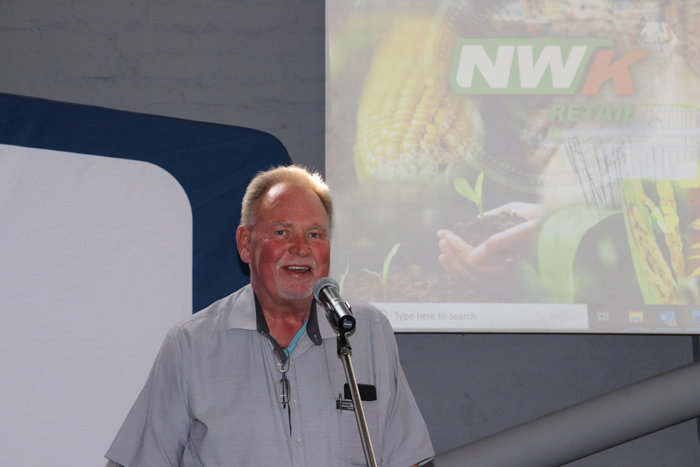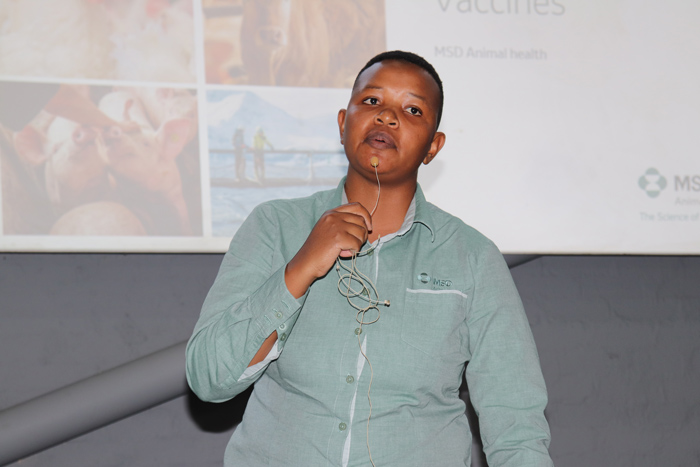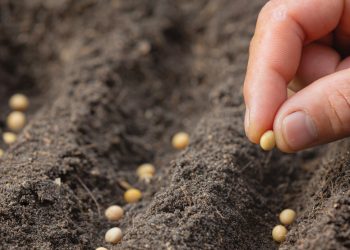
The Mahikeng Spring Farmers’ Day, hosted at NWK Retail Mahikeng on 26 August, exceeded the organisers’ wildest expectations when 200 farmers attended this insightful event.
Experts from Nutri Feeds, Virbac, MSD Animal Health, Afrivet as well as Kyron Agri addressed the farmers on issues such as animal feed, mineral supplements, the use of antibiotics, managing parasites as well as various vaccines, among others.

Mahikeng Spring Famers’ Day.
Nutri Feeds
Francois la Grange, technical advisor of Nutri Feeds, advised farmers to base their decision on what feed to use, on the following factors:
- The type of grazing to which the livestock has access.
- The type of feed available at their nearest agricultural retailer.
- The goals they want to achieve with the relevant nutrition.
- Affordability.

PHYSIOLOGICAL PHASES
These are the physiological phases that affect an animal’s nutritional needs.
- Maintenance: During this phase the animal doesn’t grow, develops a foetus or does any production. Only a state of good health needs to be maintained. Food intake should provide energy for vital bodily functions, protein for the repair of body tissues, minerals to replace losses, vitamins and water. During winter, cattle can obtain energy from the veld, protein from lick and vitamins and minerals from the veld as well as lick.
- Growth: There is an increase in muscle, bones, organs and connective tissue during this phase. Protein required for growth must be of good quality proportion and the right amounts of essential amino acids are also very important. Lots of energy is needed during this phase. Since bone formation is a primary activity during growth and bone is high in calcium and phosphorus content, these two minerals are essential for growth. Certain vitamins function in various metabolic processes related to nutrient utilisation for growth. Fat-free muscle tissue contains up to 80% water.
- Pregnancy: Energy, protein, calcium, phosphorus and vitamin D in particular is required. More than two thirds of a foetus’ growth occurs during the last trimester of pregnancy. Proper feeding during pregnancy is essential to avoid the birth of a dead or weak foetus and to build up body reserves lost during early lactation.
- Milk/egg production: Nutrients for milk production must come from the feed, either directly or indirectly via body reserves of nutrients, which come originally from the animal’s feed. The peak milk production is reached during four to eight weeks after lactation starts and the animal also loses body weight during early lactation since their appetite is low and they may not take sufficient feed to meet the nutrient requirements. During peak lactation, milk yield will be high, the feed intake will not be sufficient and the animals lose body weight. Nutritive requirements for milk production are in proportion to the amount of milk produced and are over and above those for other physiological phases of production such as maintenance, growth, fattening and foetal development.
- Work: When the animal performs some form of labour.
The right feed for each physiological phase is crucial to get the desired effect. Nutri Feeds has various licks and feeds available to cater for each of these physiological phases.
Kyron Agri
Dr JG Nel, a consulting veterinarian at Kyron Agri, educated attendees on the use of antibiotics and antimicrobials in production animals.

Firstly, he informed them to check the following when conducting a clinical examination on an animal:
- Is the animal still drinking and eating?
- Take the temperature.
- Check the colour of the mucous membrane in the eye and vulva.
- Is the breathing fast?
- Is the nose dry?
- Is the rumen still full or empty?
- Is the faeces dry, runny or bloody?
JG elaborated on the various bacteria such as E. coli, Corynebacterium, Mannheimia and Pasteurella that cause illnesses; as well as viruses like corona and rota that also cause infection. Protozoa (Cryptosporidium and Coccidiosis), rickettsiae (Ehrilicia and Anaplasma) as well as fungi (Dermatophytosis) are also culprits in terms of animal illnesses.
Medicine can be used preventatively and can be injected in feed or water. These include Oxytracyclines, Sulphonamides, Imidocarb as well as Diminazine.
Typical examples of bacterial diseases treated with antibiotics include pneumonia (symptoms are fever, lack of appetite and fast breathing) as well as diarrhoea (of which the symptoms are yellow or bloody faeces, a lack of appetite and dehydration).
Tickborne diseases such as heartwater (characterised by fever, a lack of appetite, a high stepping gait and neurological signs); redwater (characterised by fever, anaemia and red urine); anaplasmosis (characterised by fever, anaemia and yellow mucous membranes) are also treated with antibiotics.
JG stressed that, when administering antibiotics, farmers should give supportive treatment such as supplementing B vitamins, something to kick start the rumen, good quality feed and clean water, electrolytes and shade.
Kyron Agri has a wide range of antibiotics and antimicrobials that can be used to prevent and treat various diseases.
Virbac Multimin
Hans Mathebe, an area sales manager at Virbac, spoke about Multimin, an injectable multi trace mineral formulation that contains the most essential trace minerals that are required for successful reproduction in animals, a well-functioning immune system as well as optimum growth and development in young animals.

Multimin is designed for use specifically before periods of increased trace mineral demand such as breeding, calving, weaning and transport.
It contains zinc that is vital for libido and sperm quality, sexual maturity and onset of oestrus, appetite and growth, wool production, milk and udder quality, bone formation, a strong immune system as well as a healthy skin and hoofs.
Another mineral in Multimin is manganese – important for female fertility and reproduction, normal testicular development, fat, glucose and carbohydrate metabolism and immune response. It is also a structural component of bone and cartilage.
Selenium also forms part of Multimin and aids in the following: growth, fertility and prevention of disease, colostrum quality and quantity, conception, early embryonic survival and spermatogenesis. It further reduces the incidence of muscle diseases and retained afterbirths, mastitis and diarrhoea. It contains the enzyme – glutathione peroxidase – most important enzyme for natural resistance.
Multimin also contains copper. After phosphorus it is the second most limiting mineral in grazing cattle. It prevents delayed oestrus and embryonic deaths, reduces anemia and diarrhoea, forms hard bone and is essential for the health and survival of new-born calves and growth. It is an anti-oxidant and anti-inflammatory and thus important for immunity.
Lastly, it contains chromium which potentiates insulin action, increases milk production and increases growth and health of young and feedlot calves. It also aids in stressful situations such as when the animal is being transported or inducted at feedlots.
Multimin is only suitable for cattle, sheep and Angora goats. Oral supplementation should be used to supply the animal’s daily requirements of minerals, as it is practical and economical.
Injectable supplementation should be used as a top-up supplementation to supply trace minerals at critical times of elevated requirements. Injectable trace mineral combinations should be considered as a top-up to oral supplementation programmes as it is an effective complementary route of supplying trace minerals during critical periods of high demand, to improve reproduction,
production as well as immune function.
With Multimin, each animal gets the correct amount of trace minerals according to the label and their body weight and it results in less loss of the product due to spillage.
MSD Animal Health
Dr Raesibe Kekana of MSD Animal Health, educated farmers on the importance of vaccines. She explained that they contain a weakened version of the disease causing organism. The immune system gets to train soldiers for a known enemy and can react fast to heal the body.

Colostrum is vital to build up the immune system of a new-born calf/lamb which is born without one. It suckles antibodies and protein from the mother, but can only obtain these antibodies if the mother has been exposed to the disease or vaccinated against it.
HOW TO PREP THE MOTHER
- Give quality feed and mineral injections one and half months before birth.
- Vaccinate the mother against important diseases like diarrhoea, pneumonia and anthrax.
- Decrease nutritional and heat stress.
- Make sure the new-born drinks within six hours after birth.
WHEN TO VACCINATE
The following is important factors to consider when deciding on when to vaccinate:
- Vaccines must coincide with risk period.
- Maximum antibodies must be present in the colostrum.
- Lambs must be dewormed at eight to ten weeks and pulpy kidney immunity must have been established.
- Clostridial bacteria immunisation must be done before animals eat highly nutritious food.
MSD Animal Health has a wide range of vaccines available that gives protection against clostridial diseases and pneumonia, pulpy kidney and tetanus. Other vaccines protect against the sexually transmittable Chlamydophila abortus which causes abortion, still birth and weak lambs.
Farmers must vaccinate their animals against the very deadly botulism, black quarter and anthrax, especially if they are using chicken litter as feed.
Afrivet
Gaolaolwe Ishmael Digame of Training Services at Afrivet, said that injury, poisoning, infection, parasites and nutrition cause production losses and diseases.

Parasites are divided into two groups:
- Ecto or external parasites where they attach on the outside of the body.
- Endo- or internal, where they attach internally.
Ticks and tick-borne diseases are of great economic importance. The success of the livestock industry depends on the health of animals with sustained productivity.
Challenges in the control of parasites include:
- Some parasites are always present where livestock are, such as roundworms and ticks.
- Internal parasites are largely hidden, and so are their effects.
Ongoing parasite infestation is on the most important causes of low production and growth. Livestock workers can develop the necessary skills to identify heavily infested animals that need immediate treatment. The effects of parasites can be minimised by strategic seasonal treatments or strategically treating animals at specific ages or stages of production.
Direct effects of ticks on livestock include anaemia, irritation, physical damage to the skin and udder, abscesses and they have an anorexic effect. Indirect effects include redwater, gall sickness, heartwater and theileriosis.
External parasites can be killed with dip which results in either immediate death or death after some time. There are three groups of dips: Amidines – Amitraz e.g. Eraditick 250; Pyrethroids – Deltamethrin e.g. Deltapor 10 Plus as well as Organophosphates.
Flies can also be very detrimental to animal health. They cause pink eye which can lead to blindness if the eye ruptures as well as photophobia (sensitivity to light). The irritation they cause leads to stress, interrupted feeding and results in a loss of milk and meat production.
SYMPTOMS CAUSED BY INTERNAL PARASITES
The symptoms caused by internal parasites are non-specific.
Roundworms cause wasting, anaemia, bottle jaw, diarrhoea, a loss of appetite and potbelly. A rough haircoat, potbelly and growth retardation is as a result of tapeworm.
Flukes cause scarring of the liver and results in weightloss. Cattle usually build immunity against fluke, but sheep don’t. Important preventative measures include:
- Keeping livestock and freshwater snails apart
- Avoiding grazing in wetlands
- Closing off wetlands
- Keeping water troughs clean
- Treating animals that show signs of fluke infestation.
Conical flukes attach to the small intestine, causing necrosis, swelling bleeding and ulceration of the duodenum, poor absorption of nutrients, wasting, bloody diarrhoea and death.
Afrivet has a wide range of products that are effective in killing these parasites.









